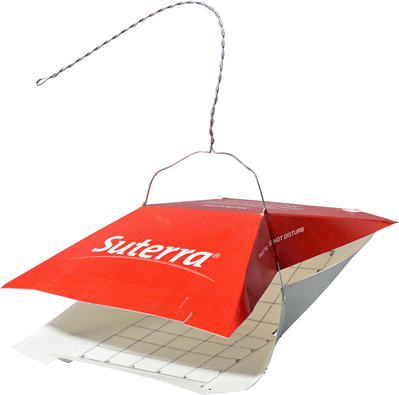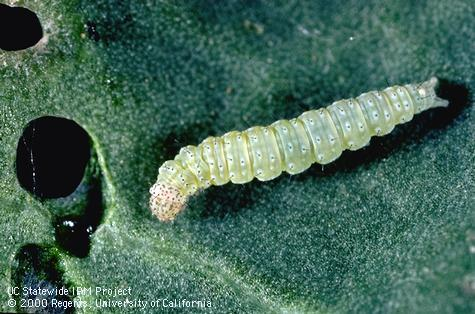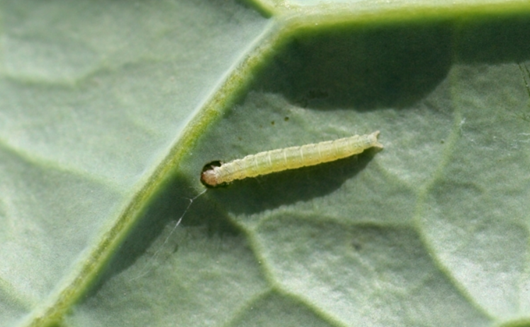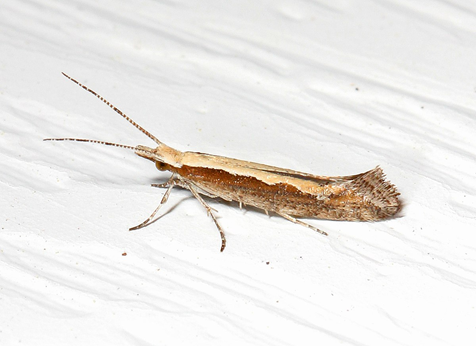


Diamondback moth can damage a wide variety of cole crops if left unchecked. Remind yourself of best practices when monitoring for this pest with these tips and tricks.

Suterra’s pheromone traps for DBM are extremely simple to set up and check. DBM Septa Lures are best used with Wing Traps, which are resilient paper-based traps that simply need to be folded into position per the included assembly instructions. Wing Traps are ideal for use with Diamondback Moth because of the abundant airflow and large surface area of the trap. Assembling a wingtrap is mostly straightforward; however, the white sticky paper should be on the bottom of the trap with the sticky side facing up. Make sure to leave a 1’’ gap between the top and bottom segments so adult moths can enter the trap.
Once you have the wing trap set up, you will want to bait it with a DBM Septa Lure. The DBM Septa lure contains the active ingredient that will attract male moths to your trap. Remove the lure from the bag with gloves or tweezers and lay the lure on its side in the center of the sticky paper.
Hang traps at a density of 1 trap per 10 to 20 acres and at least 2 traps per block. For best results, traps should be hung early in the season before you are regularly noticing DBM in your crops. Check the traps at least once per week and replace the Septa Lure every four weeks. Trap bottoms can be replaced as needed when the sticky paper is no longer sticky or coated in debris. The design of the Wing Trap allows for the bottom to be easily replaced without disassembling the entire trap.

In addition to checking for adults, you should also be regularly conducting sweeps to look for DBM larvae and subsequent crop damage. You are likely already conducting general sweeps to look for general caterpillar pests, so scouting specifically for DBM requires very little extra work.
Conduct a visual assessment of your crops weekly, paying particular attention to DBM damage to your crops at the end of each flight. Newly hatched diamondback moth larvae burrow into cotyledons and leaves and make a white trail behind where they have been feeding. Later on, larvae will leave large irregular holes or ‘window panes’ in the leaves of cole crops or chew on the growing tip of the plant, effectively killing the plant. In severe infestations, the leaves can be skeletonized or eaten completely. In some cases, DBM larvae will bore into the heads of cole crops, which is not as immediately noticeable as leaf damage but will result in the crop not being acceptable for sale.
Finding specimens of the larvae themselves can also aid greatly in confirming the presence of DBM in your crops. You are most likely to find larvae, eggs and pupae on the lower leaves of the plants.

DBM larvae next to leaf damage. Photo by Jack Kelly Clark, UC IPM
When monitoring for DBM, make sure that whoever is checking traps and crops knows how to distinguish DBM from similar cole crop pests. Larvae can be distinguished from other worms by their behavior and a few visual field marks. DBM caterpillars are significantly smaller than other major cole crop pests, segmented and taper off at both ends. The larvae also always have white spots and two prolegs at their posterior end, as well as silk glands that allow them to hang from leaves. The caterpillars will also frantically wiggle when disturbed, which is another telltale sign that you are dealing with DBM.

DBM larvae- note the segmented body and posterior prolegs. Photo by Whitney Cranshaw
Adult Diamondback moths are significantly easier to identify. The moths are small greyish-brown insects with pronounced antennae. As their name would suggest, DBM moths tent their wings over their back when they rest, during which their diamond pattern is most visible. Just as in their larval form, they are also significantly smaller than other lepidopteran cole pests, although adult size can vary in this species.

Adult Diamondback moth. Photo by Judy Gallagher
Once you’ve determined that Diamondback moths are present in your fields, you should consider what pest management strategy will work best for your farm. Diamondback moths are notoriously resistant to traditional insecticides. As a result, you should consider multiple avenues of pest management even if you choose to use chemical sprays.
Mating disruption is an effective and safe way to reduce DBM populations on your farm. Mating disruption imitates the sex pheromone of the female moth, rendering males unable to find mates and reproduce. Suterra’s CheckMate® DBM-F is a liquid product that can be sprayed just like any agrochemical. DBM-F is tank-mixable with other common chemicals and works with virtually any volume of water. In addition, the product is species-specific, so it won’t harm beneficial insects.
If you have questions about Diamondback Moth, monitoring or mating disruption, the specialists at Suterra are happy to help. Contact your local representative or email us online using this form.
Information provided herein does not constitute a recommendation. Always consult with your PCA to determine the best pest management practices and timings for your operation. Adhere to state and local regulations and the current pesticide label and check with your organic certifier.